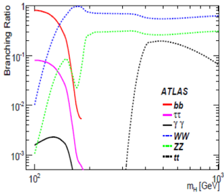Frank D. (Tony) Smith, Jr. - 2011 - http://www.valdostamuseum.org/hamsmith/
- pdf version - vixra 1107.0044 - vixra 1107.0048
Using the ideas of
African IFA Divination
Clifford Algebra Cl(8)xCl(8) = Cl(16)
Lie Algebra E8
Hua Geometry of Bounded Complex Domains
Mayer Geometric Higgs Mechanism
Batakis 8-dim Kaluza-Klein structure of hep-ph/0311165 by Hashimoto et
al
Segal Conformal Gravity version of the MacDowell-Mansouri Mechanism
Real Clifford Algebra generalized Hyperfinite II1 von Neumannn factor
AQFT
Joy Christian EPR Geometry
my
E8 Physics model has been developed with a 3-state
Higgs
system that is consistent with the preliminary
CMS LHC Higgs -> ZZ results shown on the blog of Philip Gibbs on 9
July 2011
The CMS LHC plot was posted on a Fermilab
public web site after a
Fermilab seminar at which senior CMS people presented early results
of
analysis of the first 900/pb of data for the Higgs -> ZZ decay
branch.
The peaks on the plot are
not yet statistically significant enough to constitute evidence
or discovery of Higgs states, but the two around 200 GeV and 250 GeV
seem to be roughly within about 10 per cent of my tree-level
calculations of masses of 2 (middle and high) of the 3 Higgs states of
E8
Physics. The plot also has features in the 120-160 GeV range that seem
to correspond to the low state.
Full results of analysis of 1/fb of LHC data presented at the European
Physical Society 2011 meeting on High Energy Physics (EPS HEP 2011)
tests the validity of the 3-state Higgs system of E8 Physics.
This
paper describes the results of those tests with respect to the Higgs
mass states (low,
middle, and high)
and some of their effects and some prospects for future LHC exploration,
but first here is a discussion of
the 3-state system and its relationship to Triviality and Vacuum
Stability bounds:
Triviality,
Vacuum
Stability,
and
Higgs
States
According to hep-ph/0307138 by C. D. Froggatt:
“... the top quark mass is the dominant term in the SM fermion mass
matrix ... [so]... it is likely that its value will be understood
dynamically ... the self-consistency of the pure SM up to some physical
cut-off scale /\ imposes constraints on both the top quark and Higgs
boson masses.
The first constraint is the so-called triviality bound: the running
Higgs coupling constant lambda(mu) should not develop an Landau pole
for mu < /\ .
The second is the vacuum stability bound: the running Higgs coupling
constant lambda(mu) should not become negative leading to the
instability of the usual SM vacuum.
These bounds are illustrated in Fig. 3 ... we shall be interested in
the large cut-off scales /\ = 10^19 GeV, corresponding to the Planck
scale [ I have edited this sentence to restrict coverage to a Planck
scale SM cut-off and have edited Fig. 3 and added material relevant to
my E8 Physics model with 3 Higgs-Tquark states ] ...
The upper part of each curve corresponds to the triviality bound.
The lower part of each curve coincides with the vacuum stability bound
and
the point in the top right-hand corner, where it meets the triviality
bound curve, is the quasi-fixed infra-red fixed point for that value of
/\ . ...
... Fig. 3: SM bounds in the ( Mt , MH ) plane ...”.
Low  Mass State
Mass State
The Green Dot is the low-mass state of my 3-state E8 Physics model,
which corresponds to a 130 GeV Truth Quark and a 145 GeV Higgs.
The 145 GeV Higgs  also
comes from such calculations, and is the
Higgs
state that is necessary for agreement with arXiv 0960.0954 by Ellis,
Espinosa, Giudice, Hoecker and Riotto who require a Higgs with 135 <
MH < 158 GeV, saying:
also
comes from such calculations, and is the
Higgs
state that is necessary for agreement with arXiv 0960.0954 by Ellis,
Espinosa, Giudice, Hoecker and Riotto who require a Higgs with 135 <
MH < 158 GeV, saying:
“... the Standard Model may survive all the way to the Planck scale for
an intermediate range of Higgs masses ... We evaluate ... on the basis
of a global fit to the Standard Model made using the Gfitter package
... a global fit to electroweak precision data within the SM ... favors
MH < 158 GeV ... Lower bounds on the Higgs mass due to absolute
vacuum stability .. and finite-temperature ... and zero-temperature
metastability ... includ[ing] theoretical uncertainties ...
...[ “allow ( as Tommaso Dorigo said in an entry of 23 July 2009 on his
blog ) the SM to be valid for all energies up to the Planck scale (set
at 2 x 10^18 GeV) only if the Higgs boson has a mass above 135 GeV or
so” ]...”.
At EPS HEP 2011 (22 July)
Konstantinos Nikolopoulos of ATLAS described Higgs -> ZZ -> 4l in
slides showing:
The green dot (colors added by me) indicates 1 - 0 = 1 event over
background that I interpret as representing the low Higgs mass state.
At EPS HEP 2011 (22 July) Roberto Salerno of CMS described Higgs ->
ZZ -> 4l in slides showing:
Note the low number of events. Roberto Salerno said: "... No evidence
of a SM-like HIggs bosons has been found. ...". Although the
statistical criteria for "evidence" was not met by the CMS data, it
seems to me that the data is consistent with the 3-state Higgs of the
E8 Physics model.
At EPS HEP 2011 (22 July) Jonas Strandberg of ATLAS described Higgs
-> WW in slides saying:
"... An excess of events can be observed ... using 1 fb-1 of data ...
Corresponding to about 2.5 sigma in the
range 130 < MH < 150 GeV ...".
At EPS HEP 2011 (22 July) Kyle Kranmer of ATLAS described Higgs
Combination of decays in slides saying:
"... In the low-mass range (120-140 GeV) an excess of events with a
significance of approximately 2.8 sigma is observed ...
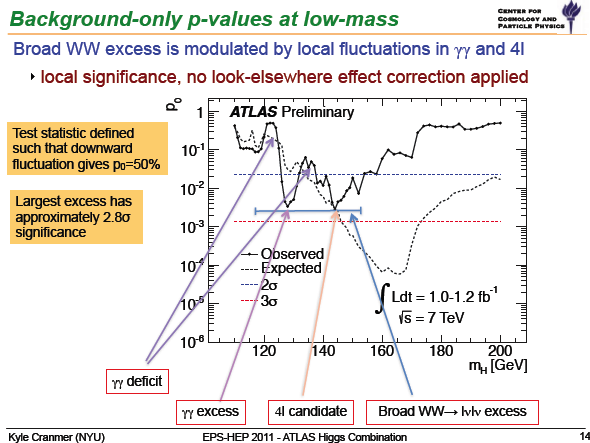
... Noticeable excess around 250 GeV
from H -> ZZ -> 4l candidates ...
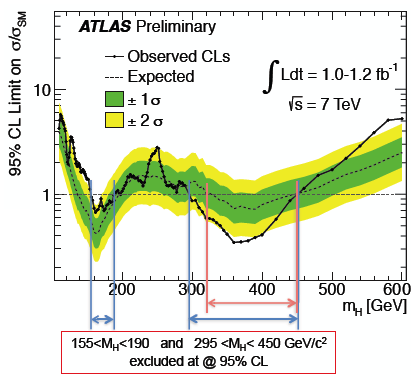
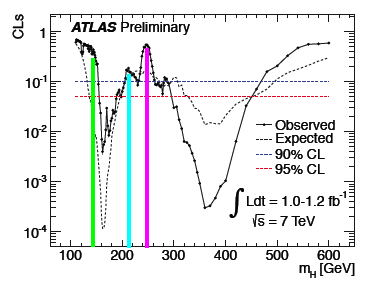
...".
I added the green, cyan, and magenta
bars indicating my identification
of plot peaks with low, middle, and high Higgs mass states.
The 130 GeV Truth Quark mass
value comes from tree-level fundamental
geometric and combinatorial calculations. At EPS HEP 2011 (21 July)
Viviana Cavaliere of CDF described a Wjj bump in slides showing:
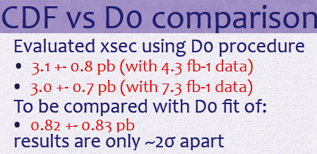
The D0 results were also presented at
EPS HEP 2011 (21 July), claiming consistency with the minimal
Standard Model and refutation of a narrow interpretation (a 4 pb cross
section with no error bars) of the CDF results.
LHC results presented at EPS HEP 2011 (21 July) by Tetiana
Berger-Hrynova who said that ATLAS saw
"... No significant excess over Standard Model processes seen in 1.02
fb-1 of data ...[ but ]...
This channel is not optimal at LHC with W+jet bkg 20 times higher ...".
The CDF Gaussian Peak is located at 147 GeV which is within about 10%
of the 130 GeV value of the E8Physics tree-level calculation. The 130
GeV value is well inside the 120-160 GeV range described for the Wjj
bump in the CDF paper at arxiv 1104.0699 which said "... we estimate
a cross section times the particle branching ratio into dijets of the
order of 4 pb. ...".
My view of all the cross section results taken together is that they
are roughly consistent
with a singleT cross section of 2.90 pb (see arxiv 1104.4087 by Plehn
and Takeuchi).
An objection to Tquark as cause of the excess was raised by Giovanni
Punzi
in slides 31 and 33 of his 2011 Blois Rencontres presentation where he
said said:
"... could this be top background [ arXiv: 1104.4087, arXiv: 1104.3790]
...
the answer is NO - this cannot possibly be top background
- there is no significant tagged component ...".
However,
As to b-tagging, the CDF update on the Wjj bump said:
"... b-tagging in the excess region ... No significant enhancement of
b-tagged events is observed in
the "excess" region compared to the sideband regions. ... This
highlights that ... the excess is not
due to an under-estimated t-tbar content since in these events at least
one of the jets should give rise
to a b-quark in the "excess" region" ...",
so
while lack of tagging might be an argument against t-tbar causing the
excess,
my position is that singleT might cause the excess.
As to b-tagging for singleT, Sullivan and Menon in arxiv 1104.3790 said:
"... one may wonder whether there is a large excess in the 2 b-tag CDF
dijet invariant mass. CDF
has measured that signal in an analysis to search for Higgs production
in WH to Wbbbar. There are
two reasons we do not expect to see a large excess in that study.
First, the deficit in Wbb from tchannel
single-top is almost perfectly cancelled by the excess in the s-channel
single-top contribution.
The basic cuts in the Higgs analysis are almost identical to the
single-top-quark analysis,
and so there is no contamination from processes with additional jets.
Furthermore, in the CDF Higgs analysis, they normalize their background
subtraction to data.
Hence, any residual excess should be removed. ...".
What about T-Tbar Events ?
My view is that most of the T-Tbar events were included in the Tquark
background in the analysis processes
used by CDF and D0 and LHC.
Middle  Mass State
Mass State
The Gold Line is based on Renormalization Group calculations with the
result that MH / MT = 1.1 as described by Koichi Yamawaki in
hep-ph/9603293 .
If you follow the Renormalization Gold Line up to higher energies from
the Green Dot low-mass state you encounter the Triviality Bound at the
Cyan Dot.
The Cyan Dot is the middle-mass state of my 3-state E8 Physics model,
which corresponds to a 174 GeV Truth Quark and a 180 GeV Higgs.
The 180 GeV Higgs  corresponds to the Higgs mass calculated by
Hashimoto, Tanabashi, and Yamawaki in hep-ph/0311165 where they show
that for 8-dimensional Kaluza-Klein spacetime with the Higgs as a
Truth Quark condensate 172 < MT < 175 GeV and 178 < MH <
188 GeV.
corresponds to the Higgs mass calculated by
Hashimoto, Tanabashi, and Yamawaki in hep-ph/0311165 where they show
that for 8-dimensional Kaluza-Klein spacetime with the Higgs as a
Truth Quark condensate 172 < MT < 175 GeV and 178 < MH <
188 GeV.
8-dimensional Kaluza-Klein structure was described with respect to
Standard Model gauge groups by N. A. Batakis in Class. Quantum Grav. 3
(1986) L99-L105 . Spinor structures in E8 Physics allow consistent
treatment of fermions.
The physical meaning of the Triviality Bound is described by Pierre
Ramond in his book Journeys Beyond the Standard Model (Perseus Books
1999) where he says at pages 175-176:
“... for a ... (large) Higgs mass, we expect the standard model to
enter a strong coupling regime ... losing ... our ability to calculate
... it is natural to think ... that the Higgs actually is a composite
... The resulting bound ... is sometimes called the triviality bound.
The reason for this unfortunate name (the theory is anything but
trivial) stems from lattice studies where the coupling is assumed to be
finite everywhere; in that case the coupling is driven to zero,
yielding in fact a trivial theory. In the standard model ... the
coupling ... is certainly not zero. ...”.
At EPS HEP 2011 (22 July)
Konstantinos Nikolopoulos of ATLAS described Higgs -> ZZ -> 4l in
slides showing:
The cyan dot (colors added by me) indicates (2 - 1) + (3 - 1) = 3
events over
background that I interpret as representing the middle Higgs mass
state.
At EPS HEP 2011 (22 July) Roberto Salerno of CMS described Higgs ->
ZZ -> 4l in slides showing:
Note the low number of events. Roberto Salerno said: "... No evidence
of a SM-like HIggs bosons has been found. ...". Although the
statistical criteria for "evidence" was not met by the CMS data, it
seems to me that the data is consistent with the 3-state Higgs of the
E8 Physics model.
At EPS HEP 2011 (22 July) Kyle Kranmer of ATLAS described Higgs
Combination of decays in slides showing:


I added the green, cyan, and magenta
bars indicating my identification
of plot peaks with low, middle, and high Higgs mass states.
The 174 GeV Truth Quark mass
value corresponds to the conventional
accepted mass of the Truth Quark.
High  Mass
State
Mass
State
If you follow the Renormalization Gold Line up to still higher energies
from the Cyan Dot middle-mass state you get to the Critical Point at
the Magenta Dot.
The physical significance of the Critical Point is described in
hep-ph/0307138 by C. D. Froggatt who said:
“... the point in the top right-hand corner, where it meets the
triviality bound curve, is the quasi-fixed infra-red fixed point for
that value of /\ . ... the SM one loop renormalization group equation
for the top quark Yukawa coupling ...[and the]... renormalization group
equation for the Higgs self-coupling ... lead... to the SM fixed point
predictions for the running top quark and Higgs masses: MT = 225 GeV
...[and]... MH = 250 GeV ...”.
The Magenta Dot is the high-mass state of my 3-state E8 Physics model,
which corresponds to a 220 GeV Truth Quark and a 240 GeV Higgs.
The 240 GeV Higgs  corresponds to the description in
hep-ph/9603293 by Koichi Yamawaki of the Bardeen-Hill-Lindner model and
is also roughly consistent with the Higgs Vacuum Expectation Value
calculated at tree-level in E8 Physics as 252 GeV.
corresponds to the description in
hep-ph/9603293 by Koichi Yamawaki of the Bardeen-Hill-Lindner model and
is also roughly consistent with the Higgs Vacuum Expectation Value
calculated at tree-level in E8 Physics as 252 GeV.
At EPS HEP 2011 (22 July)
Konstantinos Nikolopoulos of ATLAS described Higgs -> ZZ -> 4l in
slides showing:
The magenta dot (colors added by me) indicates 4 - 1 = 3 events over
background that I interpret as representing the high Higgs mass state.
At EPS HEP 2011 (22 July) Roberto Salerno of CMS described Higgs ->
ZZ -> 4l in slides showing:
Note the low number of events. Roberto Salerno said: "... No evidence
of a SM-like HIggs bosons has been found. ...". Although the
statistical criteria for "evidence" was not met by the CMS data, it
seems to me that the data is consistent with the 3-state Higgs of the
E8 Physics model.
At EPS HEP 2011 (22 July) Kyle Kranmer of ATLAS described Higgs
Combination of decays in slides saying:
"... Noticeable excess around 250 GeV from H -> ZZ -> 4l
candidates ...


...".
I added the green, cyan, and magenta
bars indicating my identification
of plot peaks with low, middle, and high Higgs mass states.
The interesting valley between 300 and 400 GeV is probably (in my
opinion) due to the onset of Higgs decay into Tquark pairs. See this
branching ratio plot from a slide by Gemma Wooden at a 2010 IoP meeting:
The 220 GeV Truth Quark mass
state is consistent with the description
in hep-ph/9603293 by Koichi Yamawaki of the Bardeen-Hill-Lindner model.
Experimental indications of Truth Quark high mass state is
at present ( July 2011) of low statistical significance.
Since there are 3 Higgs states in my E8 Physics model , it may also
explain some other recent observations, such as Bs -> mu mu
described by Jester in a 13 July 2011 Resonaances blog entry where he
said "... CDF just posted the latest update ... based on 7 fb-1 of data
... the branching fraction of Bs -> mu mu is ... about 2 sigma above
the expected Standard Model value ... additional Higgses could mediate
...[ this decay and ]... pump up the branching fraction ...".
Prospects for Future Exploration by LHC
The LHC can explore the energy region above electroweak symmetry
breaking (order of 1 TeV).
In that region, assuming only the Standard Model plus Gravity as
described by E8 Physics,
the Higgs mechanism will not be around to generate mass, so everything
will be massless,
which is an interesting new regime that needs to be explored because:
1 – The T and B quarks may not be so different, and the
Kobayashi-Maskawa matrix may look very different,
with possible consequences for CP violation.
2 – Massive neutrinos may lose their mass,
so neutrino oscillation phenomena may change in interesting ways.
3 – With no massive stuff, Conformal Symmetry may become important,
leading to phenomena such as:
a – Twistor stuff may be directly observable. See for example the book
Mathematics and Physics by
Manin, who says there:
“… What binds us to space-time is our rest mass, which prevents us from
flying at the speed of light,
when time stops and space loses meaning. In a [massless] world … there
are neither points nor
moments of time; beings … would live nowhere and nowhen; only poetry
and mathematics [ and the
LHC ] are capable of speaking meaningfully about such things. One point
of CP3 is the whole life
history of a free …[ massless particle ]… the smallest event that can
happen to …[ it ]…”.
b – Segal conformal cosmological stuff (maybe Dark Energy) may be
observable;
c – Since the Conformal group acts in 6-dim spacetime that could be
denoted by C6,
maybe two new large physical spacetime dimensions might emerge,
with
4+4 = 8-dim M4 x CP2 Kaluza-Klein becoming 6+4 = 10-dim C6 x CP2
Kaluza-Klein
and a connection emerging between
non-supersymmetric Bosonic String Theory whose Lattice Affinization has
Monster Group symmetry
and
a Bohm-type Quantum Theory based on interpreting Strings as World-Lines
( see tony5m17h.net/MonsterStringCell.pdf
and tony5m17h.net/QM03.pdf
).
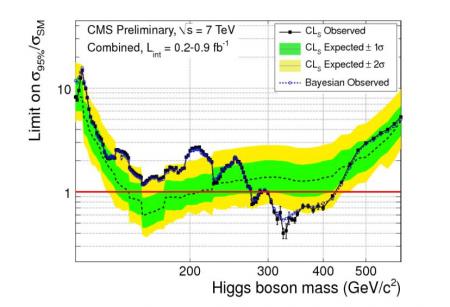
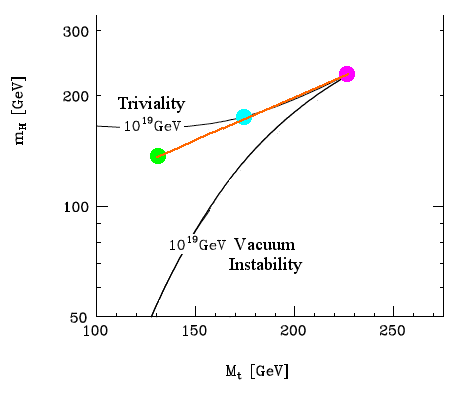
 also
comes from such calculations, and is the
Higgs
state that is necessary for agreement with arXiv 0960.0954 by Ellis,
Espinosa, Giudice, Hoecker and Riotto who require a Higgs with 135 <
MH < 158 GeV, saying:
also
comes from such calculations, and is the
Higgs
state that is necessary for agreement with arXiv 0960.0954 by Ellis,
Espinosa, Giudice, Hoecker and Riotto who require a Higgs with 135 <
MH < 158 GeV, saying: 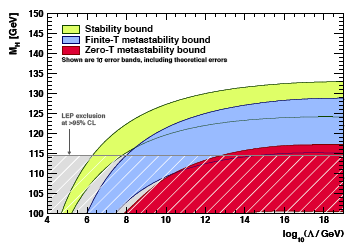
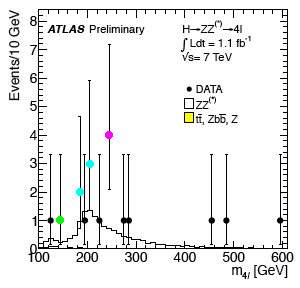
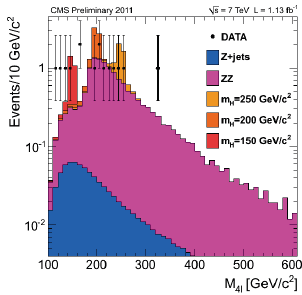


 ...".
...". 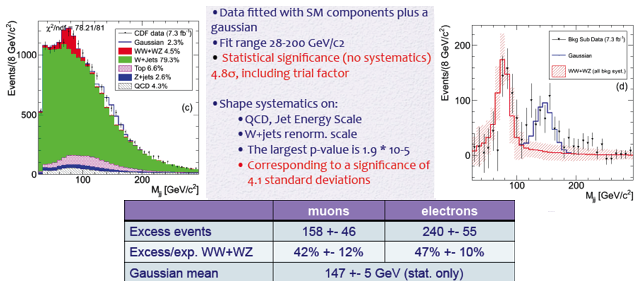

 corresponds to the Higgs mass calculated by
Hashimoto, Tanabashi, and Yamawaki in hep-ph/0311165 where they show
that for 8-dimensional Kaluza-Klein spacetime with the Higgs as a
Truth Quark condensate 172 < MT < 175 GeV and 178 < MH <
188 GeV.
corresponds to the Higgs mass calculated by
Hashimoto, Tanabashi, and Yamawaki in hep-ph/0311165 where they show
that for 8-dimensional Kaluza-Klein spacetime with the Higgs as a
Truth Quark condensate 172 < MT < 175 GeV and 178 < MH <
188 GeV. 



 corresponds to the description in
hep-ph/9603293 by Koichi Yamawaki of the Bardeen-Hill-Lindner model and
is also roughly consistent with the Higgs Vacuum Expectation Value
calculated at tree-level in E8 Physics as 252 GeV.
corresponds to the description in
hep-ph/9603293 by Koichi Yamawaki of the Bardeen-Hill-Lindner model and
is also roughly consistent with the Higgs Vacuum Expectation Value
calculated at tree-level in E8 Physics as 252 GeV. 


 ...".
...". 